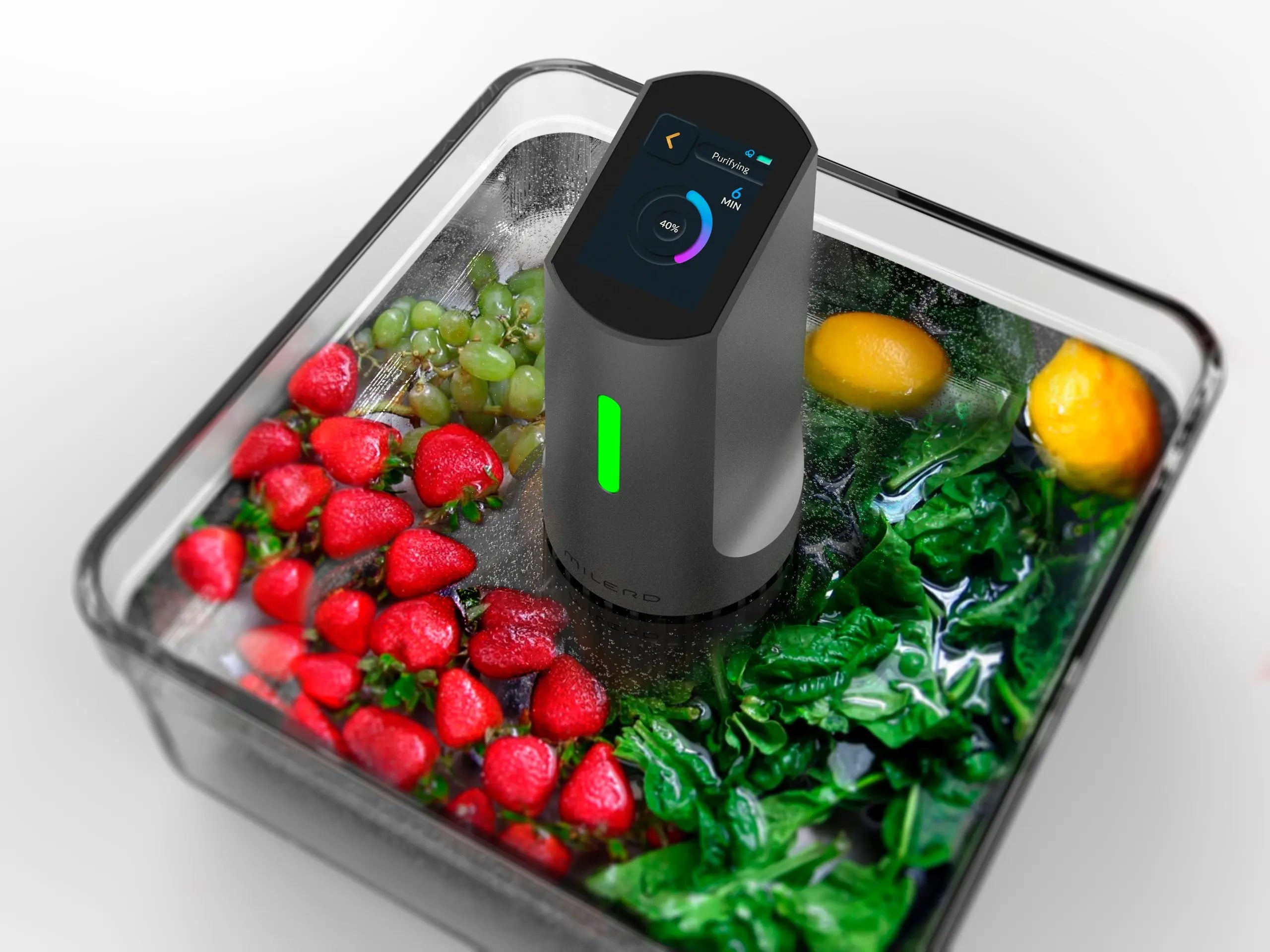Food bacteria are tiny organisms that can contaminate food and cause illness. This article covers common types, symptoms of foodborne illnesses, and essential prevention tips to ensure food safety.
Key Takeaways
-
Foodborne bacteria like Salmonella, E. coli O157:H7, and Listeria monocytogenes pose significant health risks, necessitating strict food safety practices.
-
Contamination can occur at multiple stages of food handling, from farming to processing, and ultimately in home kitchens, highlighting the need for proper hygiene and cooking techniques.
-
The Milerd Detoxer utilizes advanced technologies to effectively remove harmful contaminants from food, significantly enhancing food safety and minimizing the risk of foodborne illnesses.
Common Foodborne Bacteria

Annually, bacteria related to foodborne illnesses contribute substantially to the incidence of sickness and fatalities in the United States. Awareness and understanding of these bacteria are crucial for averting such illnesses and ensuring the safety of our food supply. These harmful microbes may be present in a range of foods, encompassing raw meats as well as fresh fruits and vegetables, especially when they come into contact with contaminated water.
By closely scrutinizing prevalent foodborne pathogens, we can better grasp their significant effect on public health outcomes.
Salmonella
Salmonella stands as the primary culprit behind deaths associated with foodborne illnesses in the United States. This particular bacterium typically inhabits raw or inadequately cooked poultry, meat, eggs, and dairy products that have not been pasteurized. The presence of symptoms like nausea and vomiting due to a Salmonella infection highlights its severe impact on public health.
Ensuring that chicken and eggs are cooked thoroughly is crucial in eradicating Salmonella bacteria from food items, thereby promoting food safety.
E. coli O157:H7
Escherichia coli, specifically the O157:H7 strain, is a major contributor to foodborne illness in the United States with an estimated 73,000 cases each year. The infection can lead to severe stomach cramps and bloody diarrhea due to this particular type of E. coli.
To avoid contracting such illnesses, it’s crucial to be vigilant about consuming properly cooked beef, avoiding raw milk products, and ensuring that water has not been contaminated. These measures are key in preventing foodborne infections linked to this pathogen.
Listeria monocytogenes
Listeria monocytogenes represents a significant threat as it can lead to listeriosis, an intense infection that poses severe risks, especially for pregnant women and those with weakened immune systems. It is frequently encountered in foods like unpasteurized dairy products, deli meats, and smoked fish.
The potential severity of a Listeria infection underscores the critical importance of adhering to rigorous food safety protocols to hinder contamination.
Staphylococcus aureus
The bacterium Staphylococcus aureus, frequently present on human skin, is notorious for generating toxins that can swiftly cause symptoms such as vomiting following consumption. This microbe has a tendency to contaminate food through inadequate hygiene measures, with cooked high-protein items like meats commonly implicated in cases of contamination. Such occurrences highlight the critical need for rigorous adherence to food safety and hygiene standards to prevent this type of bacterial presence in foods.
Clostridium botulinum
Clostridium botulinum is responsible for releasing a powerful toxin that can lead to botulism, an extreme and sometimes deadly disease. This illness frequently stems from home-canned foods that have not been prepared correctly and honey given to infants under one year of age.
The significance of proper food preservation methods and safety protocols is underscored by the effectiveness of thermal processing in neutralizing spores from Clostridium botulinum. It’s essential to use correct canning techniques to ensure food safety.
How Food Becomes Contaminated
Contamination of food is a process that can transpire during multiple phases, including cultivation and harvest, as well as throughout processing, storage, transportation, and preparation. Understanding the ways in which food can become contaminated is crucial for averting illnesses related to foodborne contaminants. These contaminations may stem from interactions with tainted water or animals or through deficient handling methods, thereby presenting numerous angles to tackle within the realm of food safety.
We shall delve into the various points at which contamination might take place and discuss strategies for minimizing these hazards.
Farm Practices
The onset of contamination frequently occurs on farms, where the feces from infected animals and soil can harbor bacteria such as E. coli O157:H7. This bacteria has the potential to contaminate various food sources including produce, raw milk, and unpasteurized dairy products, along with juices that have not been pasteurized.
To guarantee safety in our food supply at this initial stage requires rigorous adherence to appropriate hygiene and handling measures which serve to inhibit the proliferation of these dangerous microorganisms.
Processing and Packaging
The processing and packaging stage is another critical point where food can become contaminated. Cross-contamination can occur when raw and cooked foods are processed or stored in the same area, and improper handling can introduce bacteria. Using the same cutting board for raw meat and vegetables without proper cleaning can also lead to contamination.
Maintaining strict hygiene and sanitation protocols during processing is essential to make sure food safety.
Home and Restaurant Handling
Improper handling of food or water at home or in restaurants can reintroduce bacteria, even after the food has been fully cooked. Raw eggs and juices from raw foods can contaminate other food items if not handled correctly.
Using separate utensils and surfaces for raw and cooked foods helps prevent foodborne illnesses.
Symptoms of Foodborne Illnesses
Foodborne illnesses can manifest in a wide range of symptoms, from mild stomach cramps to severe dehydration and high fever. Early recognition of these symptoms is important for seeking appropriate care and preventing complications. Symptoms can vary depending on the type of bacteria or virus involved and can start within hours or several days after consuming contaminated food.
Let’s delve into the different levels of symptoms to understand their impact.
Mild Symptoms
Symptoms of foodborne illnesses, often referred to as food poisoning, are frequently mild and usually do not necessitate medical care. Symptoms may include slight fever, nausea followed by vomiting, abdominal pain and cramps.
Identifying these symptoms early on is key in maintaining one’s health and avoiding the escalation of the illness.
Severe Symptoms
Individuals displaying severe symptoms of foodborne illnesses, such as persistent vomiting, high fever, and dehydration, should seek immediate medical care due to the serious health risks involved. Those with weakened immune systems are at a higher risk when faced with these illnesses and necessitate swift medical attention for recovery since a robust immune system is vital in overcoming the condition.
Long-Term Effects
Illnesses acquired from food can result in lasting consequences and severe issues, particularly for groups at risk such as elderly adults, infants, and those with compromised immune systems. Hemolytic uremic syndrome (HUS), which is a grave condition often associated with infections caused by the E. coli O157:H7 strain, has the potential to lead to kidney failure and cognitive disorientation.
Acknowledgment of these possible enduring impacts underscores the critical nature of maintaining safety standards when handling food.
Prevention Tips for Food Safety

Preventing foodborne illnesses involves a combination of proper cooking techniques, safe food storage, and strict hygiene practices. Adhering to these guidelines significantly reduces the risk of contamination and ensures food safety.
Let’s explore some practical tips to keep your food safe from harmful bacteria and pathogens.
Proper Cooking Techniques
Ensuring that food reaches the recommended internal temperature is crucial for eradicating dangerous bacteria. To guarantee safety, foods ought to be heated to a minimum of 165 °F. Employing a food thermometer can assist in confirming that the foods have attained temperatures sufficient to eliminate pathogens.
This advice holds significant importance when it comes to meat and poultry prepared raw or undercooked since these are frequent carriers of foodborne illnesses. This includes poultry that hasn’t been cooked thoroughly.
Safe Food Storage
Proper food storage is essential to prevent the multiplication of pathogenic bacteria. Refrigerators should be kept at 40°F (4°C) or lower to maintain food safety. Improper chilling and higher temperatures can increase the risk of bacteria multiplying in food.
Properly chilling fresh fruits and vegetables reduces the risk of carrying pathogenic bacteria.
Hygiene Practices
Maintaining stringent cleanliness routines is crucial for halting the transmission of pathogens in cooking areas. It’s imperative to thoroughly wash hands using soap and water, committing no less than 20 seconds to the task. Kitchen tools and countertops must be washed with soap and water as a preventive measure against cross-contamination.
In situations where soap and water are unavailable, hand sanitizers containing alcohol may serve as an adequate substitute for disinfection purposes.
The Role of Milerd Detoxer in Ensuring Food Safety
The Milerd Detoxer represents a revolutionary advancement in the realm of food safety, employing cutting-edge ultrasonic and ozone technologies to meticulously cleanse your food. This state-of-the-art device is designed to safeguard your meals by neutralizing a plethora of hazardous agents such as bacteria, viruses, pesticides, heavy metals, mold spores, and parasite eggs—all notorious culprits behind foodborne illnesses—thereby diminishing the likelihood of these ailments.
A closer look at both the employed technologies within the Milerd Detoxer and its proven efficacy unveils its valuable contributions to ensuring that our food remains safe and healthful.
Technologies Used
The Milerd Detoxer utilizes ultrasonic technology that produces sound waves to form cavitation bubbles in liquid, efficiently eliminating impurities from the surface of food. It also incorporates ozone technology which oxidizes and decomposes organic pollutants, thus neutralizing bacteria and pesticides present in food.
By integrating both ultrasonic and ozone technologies, the device achieves comprehensive cleaning while significantly improving the safety of food.
Effectiveness
The Milerd Detoxer is extremely efficient in removing up to 99% of different pathogens and pollutants, such as bacteria and pesticides. It also concentrates on eliminating heavy metals and mold spores from food, promoting a safer eating experience.
By successfully purifying foods from contaminants, the Milerd Detoxer greatly improves food safety for those who consume the treated products.
Usage and Benefits
The Milerd Detoxer offers a straightforward and expedient method to clean food, completing the task in approximately 10 minutes. This swift procedure maintains the original flavor and nutritional content of the foods being cleaned, thereby providing an optimal approach for upholding food safety without sacrificing quality.
This detoxing device is versatile enough to handle a broad array of food types such as fruits, vegetables, grains, meats, and seafood.

Summary
Understanding the causes, symptoms, and prevention tips for foodborne illnesses is crucial for maintaining food safety. By being aware of common foodborne bacteria and implementing proper cooking, storage, and hygiene practices, we can significantly reduce the risk of contamination. The Milerd Detoxer offers an innovative solution to ensure food safety by effectively removing harmful elements from food. Stay informed, practice safe food handling, and take advantage of advanced technologies to protect your health and well-being.



Laat een reactie achter
Deze site wordt beschermd door hCaptcha en het privacybeleid en de servicevoorwaarden van hCaptcha zijn van toepassing.